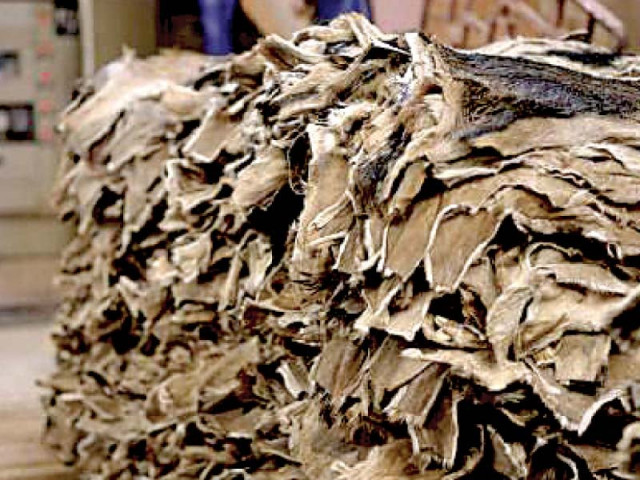Leather sector issues need immediate attention
Output of industry fell despite substantial growth in large-scale manufacturing amid Covid-19

The State Bank of Pakistan’s (SBP) Annual Report 2020-21 shows that Pakistan’s leather industry contracted significantly in FY21 which demands serious attention of the policymakers.
Although the leather industry of Pakistan has been underperforming for the past several years but the last two years have been particularly alarming for it. In these two years, a sharp decline was witnessed in the industry’s output which resulted in 9.1% and 26.4% contraction in growth in FY20 and FY21, respectively.
It is ironic that leather sector’s production has gone down despite a surge in large-scale manufacturing (LSM) which grew substantially despite Covid-19 related challenges. After textile, leather is the largest export oriented industry of Pakistan but it seems that all three democratic tenures (PPP, PMLN and PTI) failed to exploit the true potential of this segment.
Although the leather sector has been enjoying a handful of incentives including exemption from customs duty on imports and low regulatory duties but still the desired growth in exports is yet to materialise. The key reason is expensive imports due to persistent devaluation of rupee against the US dollar. Owing to absence of locally produced accessories, majority of the raw material for leather garment manufacturing, such as zips, buttons and threads, has to be imported. This drives up the cost of production, lowering the competitiveness of Pakistan’s leather products in the global export market.
What data says
Data released by International Trade Centre (ITC) showed that Pakistan’s leather exports slid from $1.25 billion in 2011 to $0.85 billion in 2020.
Data from the Pakistan Bureau of Statistics (PBS) revealed that exports of leather and leather goods fell from $918.13 million in FY17 to $833.19 million in FY21. The sector’s earnings moved from $765.35 million in FY20 to $833.19 million in FY21, rising by 8.86%. However, this growth was witnessed primarily due to low base of the preceding year.
The recent growth observed in leather exports was seen due to two reasons. First, there was an increase in the average unit price per square meter of tanned leather (from $10.89 in FY20 to $12.9 in FY21) and second, export volumes registered a rise. Outward shipments of leather apparel and clothing surged 28.54% while export of gloves and footwear increased by 36.5% and 21.9% respectively.
Tanned leather export
Had the production of tanned leather not dropped by 25.7% alongside a reduction in values of other leather goods, Pakistan could have fetched far higher foreign exchange earnings.
The huge difference between export of tanned leather in FY20 and FY21 demands some explanation. The Pakistan Economic Survey 2020-2021 shows meagre difference of 2.5% in the production of hides and skins—77.6 million in FY20 against 79.6 million in FY21.
The main reasons behind this are absence of swift collection of fresh hides and skins with modern preservation techniques and lack of skilled and trained labour for primary storage to avoid spoilage. Tanneries have to upgrade their technologies. They should also consider establishment of Combined Effluent Treatment Plants (CETPs) to mitigate environmental degradation which would help them gain certifications of leather products from international accredited agencies like Leather Working Group (LWG).
According to ITC trade map’s ranking of leather product exports, two of our neighbors are among top ten exporters in the world. China ranks first with total leather exports of almost $60 billion in 2020 and India is placed at 10th with export value of around $3.76 billion.
Based on the ITC trade map, total global export value of the commodity stood at $186.5 billion which means that more than one-third of the global exports are covered by these two countries whereas Pakistan’s share is below 0.5% and it ranks at 22nd on the leather exporters list. This should definitely be a matter of concern for the authorities and they should find an immediate remedy to the mistakes made in the past with regard to promotion of leather and leather products’ exports.
A country rich in livestock should have a seamless and high performing meat and leather industries. Pakistan is one such country but we do not see the twin industries performing at their actual potential. These underperforming industries need a well-integrated vision along with the implementing capacity to develop a long value-chain starting from modern slaughter houses to efficient tanneries equipped with latest technology to finished leather garments manufacturing units.
Apart from striving to obtain high yield of finished leather, many more steps need to be taken. Since fashionable leather goods including handbag, shoes, jewelry and watches are considered high-end value-added items, establishment of new fashion designing institutes across the country is necessary to increase export earnings through these items. Relying only on two major institutes National Institute of Leather Technology (NILT) and Leather Product Development Institute (LPDI) to seek a greater share in the global export pie is not good.
The writer is a mechanical engineer, pursuing masters degree
Published in The Express Tribune, December 6th, 2021.
Like Business on Facebook, follow @TribuneBiz on Twitter to stay informed and join in the conversation.


















COMMENTS
Comments are moderated and generally will be posted if they are on-topic and not abusive.
For more information, please see our Comments FAQ